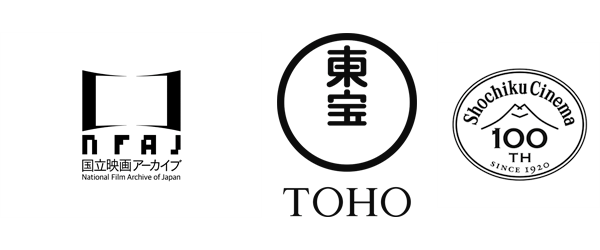Kon Ichikawa is often seen as a key modernist figure, bridging the gap from the classical golden age of the 1950s to the more formally experimental 60s. Alongside literary adaptations (notably 1955’s Kokoro and 1958’s Conflagration) and contemporary satires, he made abrasive youth movies (Punishment Room, 1956), period gangster movies (The Wanderers, 1973) and commercial thrillers (The Noh Mask Murders, 1991). He was also appointed to such prestigious commissions as the official chronicle of the 1964 Tokyo Olympics, Tokyo Olympiad (1965), and the multiscreen work Japan and Japanese for the 1970 Osaka Expo.
Some of these were hugely successful at the box office, but the lack of distinctive visual tropes or recurrent themes in his work has led to him being considered a solid helmsman rather than an auteur. There’s no overt political comment or agenda that compares to contemporaries like Shohei Imamura or Nagisa Oshima.
And yet, looking more closely, you’ll be sure to notice his painterly eye for a strong image (he’d started his career as an illustrator). There’s also the frequent dramatic focus on the psychology of the solitary individual who, by choice or by accident, is set apart from Japanese society.
Ichikawa’s most visually distinctive film is 1963’s An Actor’s Revenge. A remake of a 1930s Teinosuke Kinugasa serial of the same name, this was produced to celebrate the 300th film appearance by star Kazuo Hasegawa, who reprises his role as the ‘oyama’ female impersonator and toast of the kabuki theatre world who takes revenge against those responsible for his parents’ death.
For his version, Ichikawa goes all out with a startling representational approach that both celebrates and parodies Japan’s artistic and theatrical conventions. He fills the ’Scope screen with bold colours, simple geometric abstractions and de-centred compositions, teasingly leaving vast areas plunged into pitch darkness and nudging our attention to the action that might be unfolding outside of the frame. Even so, it’s Hasegawa’s gleefully exaggerated, effete performance that steals the show.
Jasper Sharp, bfi.org.uk
Yukinojô henge (literally, Yukinojô the Phantom) has always been taken far more seriously in the West than it was in Japan. Western commentators, generally taken with its florid exoticism, admire everything from the play with ‘Scope framing to the perversity of the love scenes and the quasi-Brechtian elements of deliberate artifice; most Japanese critics cannot get past the project’s fundamental absurdity. The original story was written for newspaper serialisation by Otokichi Mikami (1891-1944), and it was first adapted as a movie in 1935 by Teinosuke Kinugasa, who had begun his own career as a female impersonator on stage and in silent movies. Kinugasa’s adaptation starred Kazuo Hasegawa (1908-84) in the dual roles of the effeminate Yukinojô and the dashingly virile Yamitaro; it was an offbeat star vehicle by Shochiku’s standards of the 30s, and one of Kinugasa’s more intriguing entertainments. But it was not an obvious candidate for a remake nearly three decades later, least of all with the ageing Hasegawa reprising his dual roles. The Daiei management hit on the idea of the remake as a way of celebrating Hasegawa’s 300th screen appearance (the opening caption proclaims this motive), but they insured themselves commercially by surrounding him with five of their most popular contract stars, some of them squeezed into fleeting cameos. And they assigned the challenge of bringing the hopelessly dated, kitschy material to life to their most reliable contract director, Kon Ichikawa, whose films routinely turned up in the annual Kinema Junpo ‘Ten Best’ list.
Ichikawa responded, characteristically, by having fun. Far from trying to update or modernise the material, he gleefully accentuates its creakiness by using a battery of archaic visual and dramatic devices: iris effects, overtly theatrical settings and staging, characters who muse aloud to themselves, lurid lighting changes and so on. (He even enlists the well-known veteran benshi Musei Tokugawa to speak the closing narration.) Equally, he does nothing to disguise the plot’s blatantly opportunistic contrivances but plays them up in a series of weird disjunctions. He thinks nothing of slipping in a brief disquisition (complete with roller-caption) on the rice riots of the 1830s to help explain the manipulations of the commodity market; indeed, he relishes the incongruity of this gesture towards historical realism by placing it between a scene in which Ohatsu flirts with Yamitaro to a score of cocktail jazz and one in which Yukinojô stokes Namiji’s forbidden ardour to a score of lush Hollywood strings. In the context of early 60s cinema, these archaisms and crashing gears had an almost avant-garde thrust in the eyes of Western viewers. For a Japanese viewer, though, the sheer density of generic clichés prevents the film from transcending its pulp origins.
At this remove, it’s easy to see a parallel between Ichikawa’s work on Yukinojô Henge and, say, Seijun Suzuki’s exactly contemporary work on yakuza thrillers for the Nikkatsu company, which takes a similar delight in pushing genre conventions to absurdist extremes and makes equally inventive use of theatrical sets and mannerist widescreen compositions. Suzuki’s films, like Yukinojô, have to be seen as responses to a moribund studio system: desperately resourceful attempts to reactivate inert genre material by contract directors who had little or no say over the projects assigned to them. Their valiant efforts to triumph over clueless managements were, of course, doomed: Daiei went bankrupt at the end of the 60s, only a couple of years before Nikkatsu rethought company policy and began producing soft-porn quickies. There is, however, an important difference between Suzuki and Ichikawa. Suzuki, even at his wildest, never tries to subvert the moral and philosophical principles on which his genre movies rest. Ichikawa, in this film at least, goes through the genre motions efficiently but without commitment. Since the material has no intrinsic meaning in his eyes, he feels free to turn the movie into a playful aesthetic exercise.
As such, Yukinojô henge is an enjoyably camp but inescapably shallow delight. Mikami’s ludicrous premise that Yukinojô should be both a kabuki star and a skilled martial artist (and thus have not one but two substitute father-figures in the actor-manager Kikunojo and the zen monk Isshosai) blurs the traditional Edo-period distinction between actors and men of action and paves the way for some mixing-and-matching of genre conventions. Ichikawa and his screenwriter (and wife) Natto Wada follow Kinugasa’s lead in minimising Yukinojô’s martial prowess and reassigning most of the swordplay to the macho Yamitaro – a modest concession to credibility that probably led directly to the casting of Hasegawa in both roles – but nearly all their visual and dramatic coups spring from the idea of putting a kabuki onnagata into unexpected contexts. They cannot think of much to do with the Daiei guest stars: Raizo Ichikawa, in particular, is thrown away in the insufficiently comic role of the would-be thief Hirutaro, although Shintaro Katsu makes the most of his walk-on as Namiji’s saviour. But they do well by their lead women, and their rethinking of kabuki stage conventions in cinematic terms is unfailingly witty. Ironically, the one real weakness is Hasegawa himself. Perfect as the thoroughly feminised Yukinojô, he is too flabby and indolent at the age of 55 to be believable as the wall-shinning, rooftop squatting thief Yamitaro.
Tony Rayns, Sight and Sound, May 1993
AN ACTOR’S REVENGE (YUKINOJÔ HENGE)
Director: Kon Ichikawa
Production Company: Daiei Kyoto
Producer: Masaichi Nagata
Production Manager: Tadao Murakami
Planning: Kon Ichikawa, Komei Fujii, Tomio Takamori
Assistant Directors: Masuya Nakamura, Akira Inoue
Screenplay: Daisuke Ito, Teinosuke Kinugasa, Natto Wada
Original ‘Asahi’ Newspaper Serial: Otokichi Mikami
Photography: Setsuo Kobayashi
Lighting: Kenichi Okamoto
Editor: Shigeo Nishida
Art Director: Yoshinobu Nishioka
Costume Advisor: Yoshio Ueno
Colour Technician: Toshio Kajitani
Japanese Music: Tamezô Mochizuki
Ancient Music: Yahichi Takezawa
Additional Music: Yasushi Akutagawa, Masao Yagi
Action Choreography: Shôhei Miyauchi
Stage Choreography: Kangoro Fujima
Sound Recording: Gen Otani
Sound Effects: Noburu Kurashima
Collaborators: Kazuo Ikehiro, Senkichiro Takeda, Hiroyo Kato
Cast
Kazuo Hasegawa (Yukinojô Nakamura/Yamitaro the thief)
Fujiko Yamamoto (Ohatsu)
Ayako Wakao (Lady Namiji)
Eiji Funakoshi (Heima Kadokura)
Narutoshi Hayashi (Mukuzu, Ohatsu’s partner)
Eijirô Yanagi (Hiromiya)
Chusha Ichikawa (Kikunojo Nakamura)
Ganjirô Nakamura (Sansai Dobe)
Saburo Date (Kawaguchiya)
Jun Hamamura (Isshosai)
Kikue Môri (cruel old woman)
Akiyoshi Kikuno (Yukinojô’s father)
Raizo Ichikawa (Hirutaro)
Shintaro Katsu (Hojin, fugitive from Prison Island)
Yutaka Nakamura (townsman)
Chitose Maki (townswoman)
Toshiro Chiba (ronin)
Koichi Mizuhara (Dobe’s man)
Eigoro Onoe (Shogun)
Tadashi Kato (Shogun’s retainer)
Shirô Otsuji, Tokio Oki (civil guardsmen)
Musei Tokugawa (narrator)
Hajime Koshigawa
Akira Shiga
Gen Kimura
Takeo Inoue
Takeshi Yabuya
Jun Arimura
Akira Konami
Keiko Koyanagi
Japan 1963
113 mins
The screening on Thu 11 Nov will be introduced by Jennifer Coates, The University of Sheffield
Supported by

In partnership wtih

With special thanks to

With the kind support of:
Janus Films/The Criterion Collection, Kadokawa Corporation, Kawakita Memorial Film Institute, Kokusai Hoei Co. Ltd, Nikkatsu Corporation, Toei Co. Ltd
BFI SOUTHBANK
Welcome to the home of great film and TV, with three cinemas and a studio, a world-class library, regular exhibitions and a pioneering Mediatheque with 1000s of free titles for you to explore. Browse special-edition merchandise in the BFI Shop.We're also pleased to offer you a unique new space, the BFI Riverfront – with unrivalled riverside views of Waterloo Bridge and beyond, a delicious seasonal menu, plus a stylish balcony bar for cocktails or special events. Come and enjoy a pre-cinema dinner or a drink on the balcony as the sun goes down.
BECOME A BFI MEMBER
Enjoy a great package of film benefits including priority booking at BFI Southbank and BFI Festivals. Join today at bfi.org.uk/join
BFI PLAYER
We are always open online on BFI Player where you can watch the best new, cult & classic cinema on demand. Showcasing hand-picked landmark British and independent titles, films are available to watch in three distinct ways: Subscription, Rentals & Free to view.
See something different today on player.bfi.org.uk
Join the BFI mailing list for regular programme updates. Not yet registered? Create a new account at www.bfi.org.uk/signup
Programme notes and credits compiled by the BFI Documentation Unit
Notes may be edited or abridged
Questions/comments? Contact the Programme Notes team by email

